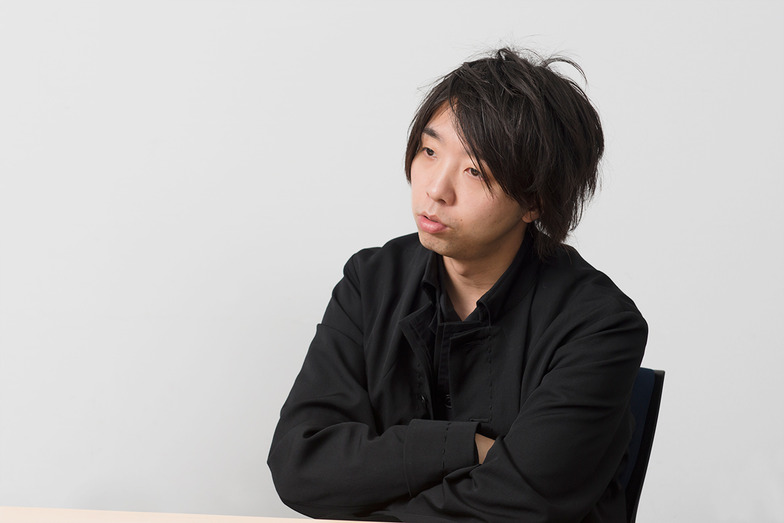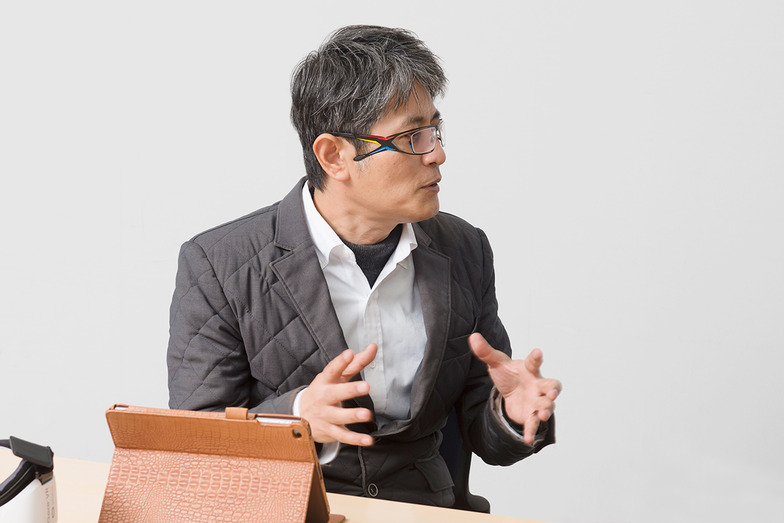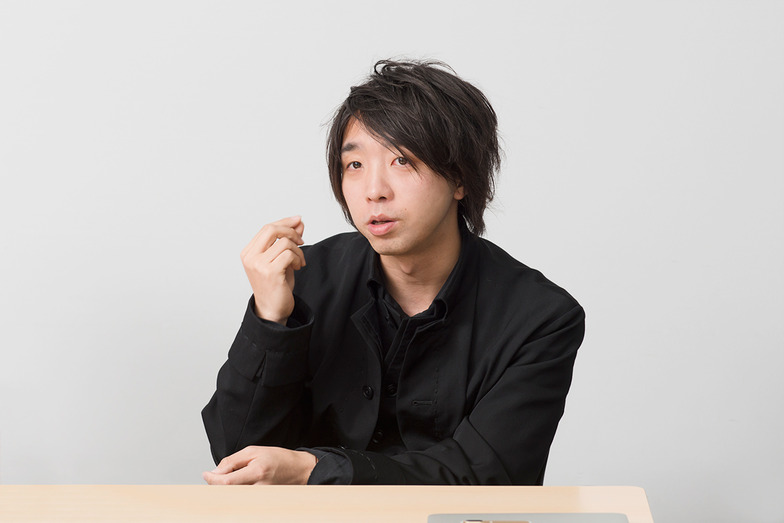New media devices are transforming communication.

Yoichi Ochiai

Adachi Hikaru
Dentsu Inc.
Media artist and researcher Yoichi Ochiai, who develops cutting-edge technologies and serves as a director of the VR Consortium, and Mitsuru Adachi of Dentsu Inc., who has been convinced of VR's potential and working on it for 20 years, look ahead to the innovation VR will bring.

A perspective diametrically opposed to television
Adachi: Since encountering VR 20 years ago, I've believed in its potential and worked on various projects. I'm thrilled that the era of VR has finally arrived. As Facebook CEO Mark Zuckerberg stated that VR is the next platform after smartphones, I feel a future where VR dominates the world's infrastructure will come much sooner than most people imagine.
Ochiai: Technology has advanced considerably. I believe the visual resolution and sense of presence needed for people to recognize it as the real world will be achieved within five or six years. Even if it can't perfectly replicate reality, there's a threshold. Once it crosses a certain line, people will say, "This is good enough!" and VR will slip in between television and real-world experiences. I suspect a significant number of people will watch the 2020 Tokyo Olympics and Paralympics in VR.
Adachi: That "immersion" in VR is an incredible technological breakthrough. And this is something you absolutely cannot grasp no matter how much you imagine it—you have to experience it. Earlier, we had Momoiro Clover Z (Momoiro Clover Z) experience their own live VR content for the first time. Their reaction was beyond what we imagined—it was amazing. The vivid sensation of seeing another version of themselves on their own stage, like an out-of-body experience, seemed particularly striking.
Incidentally, I also got the rare chance to "watch a Momoiro Clover Z live performance alongside Momoiro Clover Z" (laughs).
Ochiai: VR is "first-person" imagery. In the past, we only had third-person imagery like television, where everyone watched one screen. Then came second-person interactive formats like video calls, and now first-person VR. The movement of the viewpoint is the complete opposite between TV and VR, giving birth to entirely new filmmaking techniques. In VR footage, when the camera moves, the viewpoint direction remains fixed; when the camera is stationary, you instinctively look around to change your perspective. This is the opposite of the intent in third-person films.
Adachi: The lack of frame restrictions—meaning no fixed field of view—is another major difference. Viewers must physically move their heads, gaining the freedom to choose what to see. The volume of information increases dramatically, but conversely, creators can no longer control the viewer's perspective as intended. As you say, the production methods are entirely different from conventional video. For creators, it's an enormous challenge.
Ochiai: Regarding first-person video, perhaps we need to move beyond discussing it solely as video content and instead engage in a discussion about the new media device itself.
Adachi: Precisely what VR is. It's generally translated as "virtual reality," but I find "substantive reproduction" fits better. In other words, the essence of VR is "replacing something to a state indistinguishable from reality," and that very "concept" itself is VR, isn't it?

Creating the "Atmosphere of a Place" with Technology
Adachi: Your work and research, Ochiai-san, use technology to create something like the "atmosphere of a place," don't they?
Ochiai: I'm deeply fascinated by what exists between matter and image—something that's neither matter nor image—and how to structure it within three-dimensional space. It falls under computational holography, and personally, I've been exploring this area exclusively lately.
Adachi: You're creating things that don't actually exist within the real world, not in a virtual space.
Ochiai: For example, in the work "Whispers of the Ghostly Body," we arranged old chairs and desks in the courtyard of an abandoned school to recreate the buzz of a former classroom. It's a project that utilizes the atmosphere of the abandoned school, giving it a slightly "ghostly" feel – where only those sitting in the chairs hear the room's background noise and someone's voice.
Adachi: Creepy, but amazing! (laughs)
Ochiai: The mechanism involves developing technology that uses directional speakers placed far away to project ultrasonic vibrators in a beam-like pattern, forming a focal point in space. This creates sound audible only at that specific focal point. We can freely place sound sources anywhere in empty space. The work "Holographic Whisper" is an evolution of this. Even in noisy places like concert halls, it can deliver a whisper-like sound directly into the target person's ear. It was accepted at HCI (a prestigious conference in the interaction field) and received a national award, so it has some credibility.
Adachi: This allows incredibly free design of sound environments. The potential applications, from entertainment to business, are immeasurable.

Ochiai: We're also working on touchable images. In last year's "Fairy Lights in Femtoseconds," we realized "material images."
Adachi: Fairies flying through the air, and you could actually touch them with your fingers. It captured the world's attention, didn't it?
Ochiai: We project three-dimensional holographic images with physical substance into the air using ultra-short pulse lasers lasting one-trillionth of a second. They vanish extremely quickly without transferring heat, resulting in a cumulative energy level low enough to be relatively safe even if touched by living beings. Touching them gives a rough texture, and they can change shape, offering interactivity.
Adachi: For drawing in VR space, there's HTC Vive's Tilt Brush, but this feels like doing that in the real world.
Ochiai: By simultaneously generating an "acoustic field" and a "laser field," we create invisible forces in the air to move objects, or generate tactile sensations only in specific areas. We're exploring various other applications too. The goal is to gradually blur the boundary between physical matter and imagery.
Adachi: That seems like it could be applied to VR too, like with haptics and sound.
Ochiai: Of course, I'm also interested in how to create a sense of air within VR. We're exploring various approaches in both VR spaces and the real world. I often refer to it as the "jump step between image and matter." Repeatedly shifting from matter to image and back to matter creates a synergistic effect that sparks new forms of expression. Separating from physical mass allows for more flexible thinking. Then, envisioning impossible robotics and actually outputting them as real matter using a 3D printer... I believe this process is incredibly important.

Artists gain freedom in VR
Adachi: What's needed to further enhance immersion in VR spaces? Since sight and sound are covered, the next step is tactile feedback, right? Oculus Touch and similar technologies are already advancing toward practical use.
Ochiai: For professional applications, haptics are crucial. Tactile feedback matters for handheld tools. Light is also incredibly important. Since you don't touch everything, the atmosphere conveyed visually creates a stronger sense of presence than touch. For instance, if light comes from only one direction, moving your head creates a jarring sensation. Light fields are one of my specialties, and by meticulously controlling light distribution, we can achieve a natural feel that feels comfortable to look at for extended periods.
Adachi: Ultimately, I want to enhance the precision of every essence that can be perceived through the "five senses."
Ochiai: What really strikes me when working with VR lately is that what decides success isn't novelty anymore, but the difference in craftsmanship. Platformers like Oculus, Vive, and Sony produce high-quality content. Unlike smartphone game apps, which even amateurs can create, VR demands immense technical precision in areas like lighting and textures.
Adachi: With Momoiro Clover Z's live content, we pushed the boundaries of immersion to the extreme. But there's still room for improvement.
Ochiai: Currently, sound and visuals are based on the specifications of the human eye and ear. TV and movies are technologies tailored to humans. But I believe that if we can express something in 3D with higher resolution, transcending human senses, an interesting world could open up beyond that.
Also, regarding live performances, I believe VR can give artists much more freedom. Being temporarily detached from their physical presence opens up countless possibilities. After all, since you can't touch them anyway, why not let them take on any form?
Adachi: That's true. If we see VR not as a record but as entertainment, it really expands the scope of expression.
Ochiai: Converting the entire artist into data and temporarily separating them from their physical form. Even now, at live venues, most people enjoy the artist's visuals projected on a big screen. So, why not just become data in the first place?
You could freely scale them up or down, split them apart, or turn them into drones flying through the sky. Imagine a giant Momota from Momoiro Clover Z flying through the air, or EXILE multiplied into 180 members (laughs). People might resist it at first, but performing in VR can actually be more entertaining than what the physical body can do. And with VR, you could freely design the live venue space too.
Adachi: It seems like there could be a whole new form of live production unique to VR. I'd definitely like to try doing that with Ochiai-san.

Communication is the Keyword
Ochiai: But while entertainment like live shows is great, I think the real key to VR's widespread adoption lies in the communication domain. If everyone can use simple tools like smartphones to converse within VR spaces, VR will explode in popularity.
Adachi: That's the moment it shifts from being interesting to being useful.
Ochiai: Exactly. Right now, it's still in the "media art phase" – expressions driven by technical novelty and media criticism. Millions might be moved by this. But if it becomes a practical tool, integrates into society, and gains the gravitational pull of everyone using it together, it could instantly scale to tens of millions. That's the moment it becomes commonplace.
Adachi: I also believe VR will fundamentally evolve into the social domain. What impressed me in Facebook's demo was seeing Zuckerberg pull out his phone in the VR space, have his wife appear via Messenger, take a selfie together, and post it. Such use cases might spread quite rapidly. Designing the interface between virtual and real worlds seems key.
Ochiai: For communication, seeing each other's gaze and expressions is also crucial. Currently, gaze can be easily tracked using infrared reflection, but expressions in unseen areas must be reconstructed using AI (artificial intelligence). The speed of that reconstruction will be important. Usability should also be simplified; for example, voice control like on smartphones is needed.
Adachi: Also, the idea of spatial memory—that feeling of suddenly returning to lost places, spaces, or eras—is really appealing. Like, for a class reunion, everyone gathers in their old classroom. As Japan undergoes rapid transformation heading into 2020, the value that archives of place memory could hold is immeasurable.
Toward the Foundation of Every Industry
Adachi: VR, which enables shared experiences, is the ultimate image transmission method and a crucial technology for the advertising communication industry. Today's era is all about experience. Advertising communication is shifting away from one-way corporate messaging toward experiential formats where consumers take center stage.
With VR, you can freely participate in events or tour overseas factories. For cars, you can not only test drive them but actually drive to a campground. You could go to a great restaurant with your favorite celebrity or step into the world of a brand or commercial. Such advertising expressions might become commonplace.
Ochiai: Experience design—the design of the total human experience—will become crucial.
Adachi: The future of VR will fuse with AR (augmented reality) and AI, evolving into what's called "MR" (mixed reality). It will become simpler and more convenient, ultimately forming the foundation for every industry. Massive capital is already flowing into this overseas.
Ochiai: I'm curious to see what kind of MR device Magic Leap will develop, having raised over $1.4 billion from global giants like Google and Alibaba. Their executives have even said things like, "Yoichi, when are you going to get bored with university research? You're doing the same thing as us, so come join us when you do." I'm really interested in that kind of technological innovation.
Adachi: Wow, you should definitely go! But the VR business is just getting started. I believe Japan has many opportunities too. Beyond its rich content, it has the advantage of hosting the 2020 Tokyo Olympics and Paralympics, plus many world-class companies.
We've also launched the cross-organizational team "Dentsu Inc. VR Plus" to create value by integrating this VR innovation into people's lives and all kinds of industries. It might sound a bit grandiose, but we want to be the ones shaping the future of VR. I'd definitely like to collaborate with Mr. Ochiai on various projects going forward.
Was this article helpful?
Newsletter registration is here
We select and publish important news every day
For inquiries about this article
Author

Yoichi Ochiai
Fascinated by the potential of multimedia beyond video, he is engaged in research toward a vision he calls Digital Nature. He realizes expressions that reconstruct the boundaries between video and physical matter through computational physical fields (computational holograms). Recognized as a "Genius Programmer/Super Creator" by the Information-technology Promotion Agency. Recipient of numerous awards both domestically and internationally.

Adachi Hikaru
Dentsu Inc.
Joined the company in 1990. From the outset, he explored expressions utilizing DTP, CG, VR, and AR technologies, engaging in digital creative work for overseas markets that leveraged the latest technologies. For over 20 years, he has been involved in VR-based methodologies. In 2016, as the representative of the internal task force "Dentsu VR Plus" promoting Dentsu Inc.'s VR business, he aimed to establish VR/AR as a mainstream media and popularize it.


